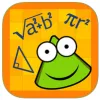Take a look inside 5 images
Geometry Quest
Pros: The motivating travel theme wraps in quizzes, and thoughtful suggestions for improvement are packaged in.
Cons: A limited number of questions limits replay value, and age appeal is somewhat narrow.
Bottom Line: Third through sixth graders will like testing their geometry knowledge with Geometry Quest.
Cartoonish graphics are perfect for third or fourth graders, yet content is challenging, reaching from properties of two-dimensional shapes all the way to the Pythagorean Theorem. On the other hand, kids who are older or more advanced may master the whole caboodle pretty quickly. Without multiple profiles or any progress tracking, this app would work best in your classroom for stand-alone skills reinforcement.
In Geometry Quest, kids travel across the world from Boston to Sydney, taking a quiz at each location. Questions are either true/false or multiple choice. If kids miss one question, they lose a passport stamp and get two stars at the end; if they miss two, they get two stars; if they miss all three, they have to play again to advance. If they get all the answers correct, they get a passport stamp displayed on the map and three stars. The "game over" screen gives the number of right and wrong answers and some encouragement.
The world map, iconic images for each city, zooming airplane, and animated character (sort of an Om Nom look-alike) combine to make an appealing narrative. Questions are well-worded and concise and usually avoid textbook language. An example is, "Do all the sides have to be the same length in a polygon?" One of the primary downsides, however, is lack of content, with only about 28 rotating questions at each of seven locations, and the game has narrow age appeal.
Feedback is gentle. When students miss a question, a small (hardly noticeable) question mark appears next to the character. If students tap the question mark, the character gives them a useful prompt, usually in the form of a question or information to consider, like, "Should you add or subtract? Draw the diagram on paper and label the lengths." Diagrams could be a tad larger, but otherwise they're simple and clear.












